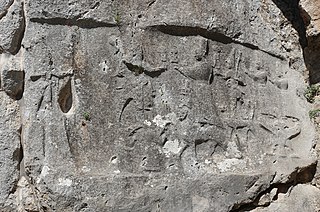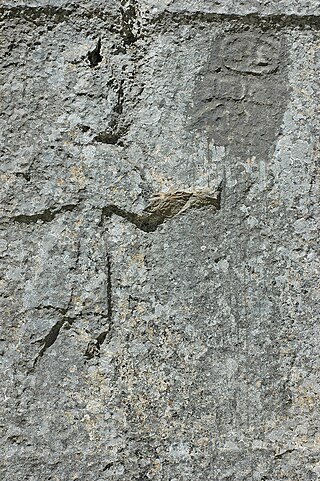Related Research Articles
Dagon or Dagan was a god worshipped in ancient Syria across the middle of the Euphrates, with primary temples located in Tuttul and Terqa, though many attestations of his cult come from cities such as Mari and Emar as well. In settlements situated in the upper Euphrates area he was regarded as the "father of gods" similar to Mesopotamian Enlil or Hurrian Kumarbi, as well as a lord of the land, a god of prosperity, and a source of royal legitimacy. A large number of theophoric names, both masculine and feminine, attests that he was a popular deity. He was also worshiped further east, in Mesopotamia, where many rulers regarded him as the god capable of granting them kingship over the western areas.

Teshub was the Hurrian god of sky, thunder, and storms. Taru was the name of a similar Hattic storm god, whose mythology and worship as a primary deity continued and evolved through descendant Luwian and Hittite cultures. In these two, Taru was known as Tarhun / Tarhunt- / Tarhuwant- / Tarhunta, names derived from the Anatolian root *tarh "to defeat, conquer". Taru/Tarhun/Tarhunt was ultimately assimilated into and identified with the Hurrian Teshub around the time of the religious reforms of Muwatalli II, ruler of the Hittite New Kingdom in the early 13th century BCE. These reforms can generally be categorized as an official incorporation of Hurrian deities into the Hittite pantheon, with a smaller number of important Hurrian gods being explicitly identified with preexisting major Hittite deities. Teshub reappears in the post-Hurrian cultural successor kingdom of Urartu as Tesheba, one of their chief gods; in Urartian art he is depicted standing on a bull.

Ḫebat or Hepat was a Hurrian goddess. She was the tutelary deity of Halab in origin, and in that role appears already in pre-Hurrian texts from Ebla. Her status was not identical in all Hurrian centers: while she was the main goddess in the pantheons of Halab and various cities of Kizzuwatna, her role in Ugarit and in eastern cities like Nuzi was smaller.
Kumarbi was an important god of the Hurrians, regarded as "the father of gods." He was also a member of the Hittite pantheon. According to Hurrian myths, he was a son of Alalu, and one of the parents of the storm-god Teshub, the other being Anu. His cult city was Urkesh.
Upelluri or Ubelluri was a primordial giant in Hurrian mythology.

Kušuḫ, also known under the name Umbu, was the Hurrian god of the moon. He is attested in cuneiform texts from many sites, from Hattusa in modern Turkey, through Ugarit, Alalakh, Mari and other locations in Syria, to Nuzi, located near modern Kirkuk in Iraq, but known sources do not indicate that he was associated with a single city. His name might be derived from the toponym Kuzina, possibly the Hurrian name of Harran, a city in Upper Mesopotamia, but both this etymology and identification of this sparsely attested place name remain uncertain. He was a popular, commonly worshiped god, and many theophoric names invoking him are known. In addition to serving as a divine representation of the moon, he was also associated with oaths, oracles and pregnancy. Some aspects of his character were likely influenced by his Mesopotamian counterpart Sin, while he in turn was an influence on the Ugaritic god Yarikh and Luwian Arma.
Yam was a god representing the sea and other sources of water worshiped in various locations on the eastern Mediterranean coast, as well as further inland in modern Syria. He is best known from the Ugaritic texts. While he was a minor deity in Ugaritic religion, he is nonetheless attested as a recipient of offerings, and a number of theophoric names invoking him have been identified. He also played a role in Ugaritic mythology. In the Baal Cycle he is portrayed as an enemy of the weather god, Baal. Their struggle revolves around attaining the rank of the king of the gods. The narrative portrays Yam as the candidate favored by the senior god El, though ultimately it is Baal who emerges victorious. Yam nonetheless continues to be referenced through the story after his defeat. In texts from other archaeological sites in Syria, attestations of Yam are largely limited to theophoric names. In Emar he was among the many deities venerated during a local festival, zukru, which took place once every seven years.
In Hurrian mythology, Ullikummi is a giant stone monster, son of Kumarbi and the sea god's daughter, Sertapsuruhi, or a female cliff. The language of the literary myth in its existing redaction is Hittite, in cuneiform texts recovered at Bogaskoy, where some Hurrian fragments of the "Song of Ullikummi" have been found. See Guterbock (1951).
Earth and Heaven were worshiped by various Hurrian communities in the Ancient Near East. While considered to be a part of the Hurrian pantheon, they were not envisioned as personified deities. They were also incorporated into the Mesopotamian pantheon, possibly during the period of Mitanni influence over part of Mesopotamia, and under the names Hahharnum and Hayyashum appear in a variety of texts, including the myth Theogony of Dunnu.

Šauška (Shaushka), also called Šauša or Šawuška, was the highest ranked goddess in the Hurrian pantheon. She was associated with love and war, as well as with incantations and by extension with healing. While she was usually referred to as a goddess and with feminine titles, such as allai, references to masculine Šauška are also known. The Hurrians associated her with Nineveh, but she was also worshiped in many other centers associated with this culture, from Anatolian cities in Kizzuwatna, through Alalakh and Ugarit in Syria, to Nuzi and Ulamme in northeastern Mesopotamia. She was also worshiped in southern Mesopotamia, where she was introduced alongside a number of other foreign deities in the Ur III period. In this area, she came to be associated with Ishtar. At a later point in time, growing Hurrian influence on Hittite culture resulted in the adoption of Šauška into the Hittite state pantheon.

Allani, also known under the Akkadian name Allatu was the Hurrian goddess of the underworld, incorporated into Hittite and Mesopotamian pantheons as well.
Aruna was the god of the sea in Hittite religion. His name is identical with the Hittite word for the sea, which could also refer to bodies of water, treated as numina rather than personified deities. His worship was not widespread, and most of the known attestations of it come exclusively from the southeast of Anatolia. He was celebrated in cities such as Ḫubešna and Tuwanuwa.

The Hurrian religion was the polytheistic religion of the Hurrians, a Bronze Age people of the Near East who chiefly inhabited the north of the Fertile Crescent. While the oldest evidence goes back to the third millennium BCE, is best attested in cuneiform sources from the second millennium BCE written not only in the Hurrian language, but also Akkadian, Hittite and Ugaritic. It was shaped by the contacts between Hurrians and various cultures they coexisted with. As a result, the Hurrian pantheon included both natively Hurrian deities and those of foreign origin, adopted from Mesopotamian, Syrian, Anatolian and Elamite beliefs. The culture of the Hurrians were not entirely homogeneous, and different local religious traditions are documented in sources from Hurrian kingdoms such as Arrapha, Kizzuwatna and Mitanni, as well as from cities with sizeable Hurrian populations, such as Ugarit and Alalakh.

Aštabi, also known as Aštabil, was a god worshiped in the third millennium BCE in Ebla, later incorporated into Hurrian beliefs in locations such as Alalakh and Ugarit and as a result also into the religion of the Hittite Empire.

Šimige was the Hurrian sun god. Known sources do not associate him with any specific location, but he is attested in documents from various settlements inhabited by the Hurrians, from Kizzuwatnean cities in modern Turkey, through Ugarit, Alalakh and Mari in Syria, to Nuzi, in antiquity a part of the kingdom of Arrapha in northeastern Iraq. His character was to a large degree based on his Mesopotamian counterpart Shamash, though they were not identical. Šimige was in turn an influence on the Hittite Sun god of Heaven and Luwian Tiwaz.

Nupatik, also known as Lubadag, was a Hurrian god of uncertain character. He is attested in the earliest inscriptions from Urkesh, as well as in texts from many other Hurrian settlements, and possibly continued to be worshiped as late as in the neo-Assyrian period. However, his functions remain uncertain.

Nabarbi was a Hurrian goddess worshiped in the proximity of the river Khabur, especially in the city Taite. It has been proposed that she was associated with the Syrian goddess Belet Nagar.

Namni and Ḫazzi were two mountain gods who belonged to the Hurrian pantheon. They are usually mentioned together in known texts. Ḫazzi corresponds to Jebel al-Aqra, while the identification of the mountain Namni represented is disputed. Both of them belonged to the court of the Hurrian weather god, Teššub, and it is possible they were worshiped alongside him in Aleppo. They are also attested in a variety of Hurrian and Hittite religious texts. They do not play an active role in known myths of Hurrian origin, though allusions to a conflict involving them have been identified in texts dealing with other deities.
Pišaišapḫi was a Hurrian mountain god. His name was derived from that of the associated mountain, Pišaiša, which was most likely located next the Mediterranean coast. He is attested in Hurrian and Hittite ritual texts from cities such as Hattusa, Šapinuwa and Ugarit. A Hittite literary text known as Myth of Pišaiša is focused on him, though its origin and the reading of the names of other deities who play roles in it remains a matter of debate among researchers.
References
- 1 2 3 4 Tugendhaft 2011, p. 712.
- 1 2 Rutherford 2001, p. 600.
- 1 2 3 Dijkstra 2012, p. 69.
- 1 2 3 4 5 Hoffner 1998, p. 51.
- 1 2 3 Tugendhaft 2011, p. 711.
- ↑ Tugendhaft 2011, p. 707.
- ↑ Rutherford 2001, pp. 603–604.
- ↑ Rutherford 2001, p. 604.
- 1 2 Rutherford 2001, p. 598.
- ↑ Tugendhaft 2011, pp. 711–712.
- ↑ Schwemer 2001, p. 547.
- 1 2 Tugendhaft 2011, p. 702.
- 1 2 Tugendhaft 2011, p. 701.
- ↑ Lambert 2013, pp. 245–246.
- ↑ Lambert 2013, p. 387.
- ↑ Lambert 2013, p. 391.
- ↑ Lambert 2013, p. 240.
- ↑ Lambert 2013, p. 244.
- ↑ Lambert 2013, p. 247.
- 1 2 Wilhelm 1997, p. 3.
- 1 2 Wilhelm 1997, p. 5.
- 1 2 Frantz-Szabó 1980, p. 74.
- ↑ Taracha 2009, p. 114.
- ↑ Wilhelm 2011, p. 399.
- ↑ Astour 1968, p. 176.
- ↑ Haas 2015, p. 409.
- ↑ Hoffner 1998, p. 40.
- ↑ Hoffner 1998, p. 41.
- ↑ Hoffner 1998, pp. 53–54.
- ↑ Ayali-Darshan 2015, p. 25.
- ↑ Hoffner 1998, p. 57.
- ↑ Dijkstra 2012, p. 73.
- ↑ Polvani 2008, p. 623.
- ↑ Ayali-Darshan 2015, p. 29.
- ↑ Rutherford 2001, p. 599.
- ↑ Rutherford 2001, pp. 599–601.
- 1 2 3 Rutherford 2001, p. 601.
- ↑ Rutherford 2001, pp. 601–602.
- ↑ Rutherford 2001, pp. 604–605.
- 1 2 Rutherford 2001, p. 602.
- ↑ Rutherford 2001, p. 606.
- ↑ Ayali-Darshan 2015, p. 31.
- ↑ Rutherford 2001, p. 603.
- ↑ Ayali-Darshan 2015, p. 30.
- ↑ Rutherford 2001, p. 605.
- ↑ Rutherford 2001, pp. 602–603.
- ↑ Ayali-Darshan 2015, p. 37.
- 1 2 3 Beckman 2003, p. 48.
- ↑ Beckman 2003, pp. 48–49.